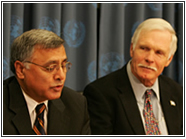Common menu bar links
Institutional links
Diseases & Conditions
Health & Safety
Research & Statistics
Agency Information
Search Box
November 17, 2004
For Immediate Release
News Release
"Early Warning" System Tracks Global Public Health Threats 24/7
GPHIN II collects and disseminates alerts in seven languages
OTTAWA/NEW YORK - The newest version of the Global Public Health Intelligence Network (GPHIN II) was jointly launched today by the Government of Canada and the Washington-based Nuclear Threat Initiative (NTI). This unique "early warning" system gathers and disseminates preliminary reports of public health significance on a real-time, 24/7 basis in seven languages.
The secure, web-based system was developed by Canadian health officials with important support and financial assistance from NTI, an organization devoted to reducing global threats from nuclear, biological and chemical weapons, co-chaired by philanthropist Ted Turner and former United States Senator Sam Nunn.
 "In a world where diseases know no borders, collaboration on public
health initiatives must also extend beyond individual nations," said Health Minister Ujjal Dosanjh. "Such incidents as SARS and avian influenza have demonstrated the importance of a strengthened network of international cooperation and communications. GPHIN is an example of the benefit of this increased collaboration."
"In a world where diseases know no borders, collaboration on public
health initiatives must also extend beyond individual nations," said Health Minister Ujjal Dosanjh. "Such incidents as SARS and avian influenza have demonstrated the importance of a strengthened network of international cooperation and communications. GPHIN is an example of the benefit of this increased collaboration."
Mr. Turner added: "We need to make the most of the tools of modern communication to inspire cooperation throughout the world for the earliest threat detection possible. There is no greater legacy we could leave our children and grandchildren than a peaceful and safer world."
GPHIN will be maintained by the Public Health Agency of Canada, which serves as the nerve centre for Canada's expertise and research in public health, effectively coordinating efforts with other partners to identify, reduce and respond to public health risks and threats. The Agency also acts as a hub for health surveillance and disease control programs.
GPHIN monitors global media sources (such as news wires and web sites), then gathers and disseminates relevant information on such topics as disease outbreaks, infectious diseases, contaminated food and water, bio-terrorism and exposure to chemical and radio-nuclear agents, and natural disasters. It also monitors issues related to the safety of products, drugs and medical devices.
The information is filtered for relevancy by an automated process and then is readily accessible to GPHIN users, which includes the World Health Organization, government authorities worldwide who conduct public health surveillance, and non-governmental organizations involved in public health issues. If the filtering identifies information about an event of significant public health risk, this information is automatically forwarded to GPHIN users by e-mail. The results of the relevancy filtering is then analyzed by the Agency's GPHIN officials to ensure accuracy of the automated process.
"Accurate and timely information on global public health issues is key to being able to quickly assess and respond to emerging health risks around the world," said Dr. Carolyn Bennett, Minister of State (Public Health).
GPHIN II enhances the GPHIN I prototype, which has been in use since 1998. While GPHIN I provided service in English, GPHIN II is a more robust, adaptable system with multilingual capacity in Arabic, English, French, Russian, Simplified and Traditional Chinese, and Spanish. Users can review the documents in the language of their choice.
"By enhancing its multiple language capacity, GPHIN II may prove to be the most important tool available for the early recognition of global public health threats - including the intentional use of a biological agent," said Senator Nunn.
 GPHIN has been lauded by public health experts worldwide, perhaps most notably by Dr. D.A. Henderson, an infectious diseases and bioterrorism expert who directed the World Health Organization's global smallpox eradication campaign.
GPHIN has been lauded by public health experts worldwide, perhaps most notably by Dr. D.A. Henderson, an infectious diseases and bioterrorism expert who directed the World Health Organization's global smallpox eradication campaign.
"GPHIN is one of the most imaginative and creative additions to global disease detection," he said. "It has demonstrated clearly that there is a surprising wealth of information in local newspapers that is worthy of attention and follow-up actions. I have spent years in many parts of the world endeavouring to establish reporting systems, and I now find GPHIN to be a key tool for the detection of significant new epidemics, wherever in the world they may occur."
The WHO has also found GPHIN to be an invaluable tool with immeasurable benefits for the global public health community.
"With early warnings of such significant events as disease outbreaks, public health officials and other government authorities worldwide are better able to undertake the measures necessary to protect the health and safety of their populations," said Dr. Stephen Corber, Area Manager of Disease Prevention and Control for the Pan-American Health Organization of the WHO.
The enhancements to the GPHIN I prototype were developed through a Collaborative Research Agreement with Canada's Nstein Technologies.
Backgrounder:
*This video webcast require the free Real Video Player plugin.
You can download the Real Video Player plugin from the Real
Media Download Center ![]() .
.
-30-
Media Inquiries:
Aggie Adamczyk
Public Health Agency of Canada
(613) 941-8189
